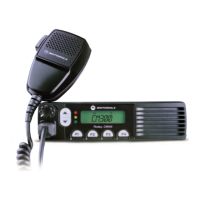5
English
INTRODUCTION
INTRODUCTION
CONVENTIONAL RADIO SYSTEMS
Conventional radio systems typically refer to
unit-to-unit communications through a single
channel. Conventional systems also allow
radio users to extend communication coverage
by relaying their messages through a repeater.
To ensure coordinated use by multiple users,
each radio user must monitor the channel or
repeater before transmitting to verify that the
system is not currently busy.
CM300 RADIO FEATURES
Radio Wide Features
• 32 Channels
• 8-Character Alphanumeric Display
• 4 Programmable Feature Buttons
• 2 Memory Channels
• Telephone Interconnect
• User-programmable Phone, Scan Lists,
TPL/DPL
• Option Board Expandability
– Secure Voice/Scrambling
– SmarTrunk II
– DTMF Decode
• Busy Channel Lockout
• High/Low Power Settings
• Local/Distance Mode
• Time-Out Timer
• Monitor and Sticky Permanent Monitor
• System Scan with 2 Priority Levels and
Revert Scan
Signaling Features
• MDC 1200 Signaling
• Quik-Call II Signaling
-Emergency
Alert
- Selective Radio
Inhibit
- PTT ID Encode/
Decode
- Call Alert
- Selective Call
- Radio Call List
- Call Tone Tag-
ging
00_Introduction.fm Page 5 Friday, July 11, 2003 11:11 AM

